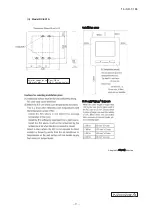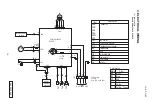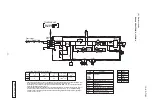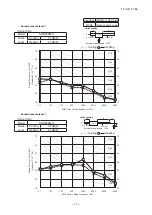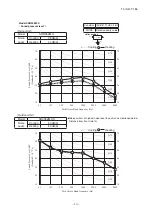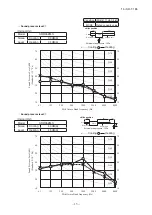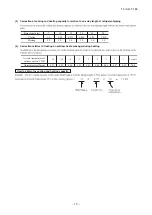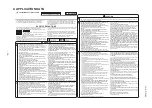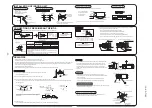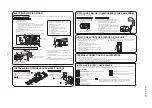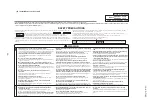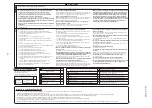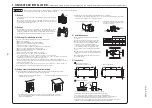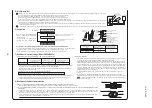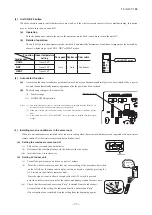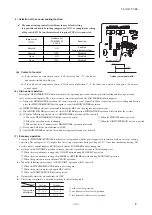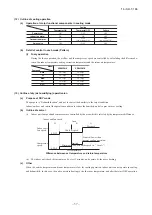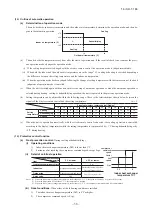
-
-
'15 • SR-T-185
• Flaring work
Measurement B
Flaring
block
Copper pipe
○ Install the removed flared nuts to the pipes to be connected,
then flared the pipes.
○ Remove the flared nuts. (on both liquid and gas sides)
Keep the openings of the pipes covered with tapes etc. to prevent dust, sand, etc. from entering them.
CONNECTION OF REFRIGERANT PIPINGS
INSTALLATION OF INDOOR UNIT
Preparation
(Do not turn)
Press
Remove
A
90 ± 0.5˚
Dimension A
Liquid side ø6.35 : 9.1 (mm)
Gas side ø9.52 : 13.2 (mm)
ø12.7 : 16.6 (mm)
CAUTION
Do not apply refrigerating machine
oil to the flared surface.
Indoor
CAUTION
Do not apply excess torque to the flared nuts.
Otherwise, the flared nuts may crack.
TERMINAL CONNECTION FOR AN INTERFACE
Remove the control lid. (Remove the screw.)
There is a terminal (respectively marked with CNS) for the indoor control board.
In connecting an interface, connect to the respective terminal securely with the connection harness supplied with an optional
“
Interface connection kit SC-BIKN-
E
” and
fasten the connection harness onto the indoor control box with the clamp supplied with the kit.
For more details, please refer to the user’s manual of your
“
Interface connection kit SC-BIKN-
E
”.
○ Connect the pipes on both liquid and gas sides.
○ Tighten the nuts to the following torque.
Liquid side (ø6.35) : 14.0 - 18.0 N
·
m (1.4 - 1.8 kgf
·
m)
Gas side (ø9.52) : 34.0 - 42.0 N
·
m (3.4 - 4.2 kgf
·
m)
(ø12.7) : 49.0 - 61.0 N
·
m (4.9 - 6.1 kgf
·
m)
Connection
Indoor
(Do not turn)
Remove the control lid.
Remove the wiring clamp.
Connect the connecting wire to the terminal block.
1) Connect the connection wire securely. If the wire is not affixed completely,
contact will be poor, and it is dangerous as the terminal block may heat up
and catch fire.
2) Take care not to confuse the terminal numbers for indoor and outdoor
connections.
Fix the connecting wire by wiring clamp.
Connect the connector of the remote control singnal receiver to the relay wiring.
Attach the control lid.
ELECTRICAL WIRING WORK
Preparation of indoor unit
Mounting of connecting wires
RJJ012A002
Liquid side
Gas side
Use cables for interconnection wiring to avoid loosening of the wires.
CENELEC code for cables Required field cables.
H05RNR4G1.5 (example) or 245IEC57
H Harmonized cable type
05 300/500 volts
R Natural-and/or synth, rubber wire insulation
N Polychloroprene rubber conductors insulation
R Stranded core
4or5 Number of conductors
G One conductor of the cable is the earth conductor
(yellow/green)
1.5 Section of copper wire (mm
2
)
○
In case of faulty wiring connection, indoor unit does not operate. Then, run lamp turns on and timer lamp blinks.
○ Attach the washers and nuts to the
suspension bolts.
○ Attach the hanging tool to the above
nuts, and tighten the nuts.
M10 washer
M10 nut
M10 suspension bolt
M10 nut
M10 washer
M10 spring lock washer
Main fram
e
Inserts
Holed anchor
Holed plug
Suspension bolts M10
Concrete
If steel embedded ceiling
Let the pipe side be slightly sloped.
Pipe side
Pour water
Water
surface
0~5mm
Vinyl hose
B
A
unit : mm
Model
25, 35
50, 60
Inlet
160
Outlet
99
Adjustment for horizontality
•
Adjust so the bottom side of
the unit will be leveled with
the water surface as
illustrated below.
Air inlet and outlet size
○ Size of air inlet and outlet of the plate.
○ Cover the flare connection part of the indoor unit with attached insulation material after a gas leakage
inspection, and tighten both ends with attached bands.
•
Make sure to insulate both gas pipes and liquid pipes completely.
※
Incomplete insulation may cause dew condensation or water dropping.
•
Use heat-resistant (120 °C or more) insulations on the gas side pipes.
•
In case of using at high humidity condition, reinforce insulation of refrigerant pipes.
Surface of insulation may cause dew condition or water dropping, if insulations are not reinfoced.
<
The case of using thickness of insulation is 10mm
>
<
The case of using reinfoced insulation
>
Pipe cover
Unit
Unit
Band
Band (Prepare on site)
Insulation (Prepare on site)
Pipe cover (Prepare on site)
Band
The thickness of insulation is 10mm
•
If the bottom drain piping can be done with a descending gradient (1/50-1/100), it is
possible to connect the pipes as shown in the drawing below.
•
When sharing a drain pipe for more than one unit, lay the main pipe 100mm
below the drain outlet of the unit. In addition, select VP-30 or bigger size for
main drain pipe.
Descending slope greater
than 1/100
VP-30 or bigger
As wide as possible
(about100mm)
○
Install the drain pipe according to the installation manual in order to drain properly.
Imperfection in draining may cause flood indoors and wetting the household goods, etc.
○
Do not put the drain pipe directly into the ditch where toxic gas such as sulfur, the other harmful and inflammable gas is generated. Toxic gas would flow into the room and it
would cause serious damage to user’s health and safety (some poisoning or deficiency of oxygen). In addition, it may cause corrosion of heat exchanger and bad smell.
○
Connect the pipe securely to avoid water leakage from the joint.
○
Insulate the pipe properly to avoid condensation drop.
○
Check if the water can flow out properly from both the drain outlet on the indoor unit and the end of the drain pipe after installation.
Insulating material
(to be removed)
Joint
Rubber stopper
(to be removed)
Standard hard polyvinyl
chloride pipe
Connecting port of bottom
drain pipes
(Outside diameter:25mm)
Connecting port of top drain pipe
DRAIN PIPE
(3)
Make sure to make descending slope of greater than 1/100 and do not make up-down bend and/or trap in the midway.
•
Pay attention not to give stress on the pipe on the indoor unit side, and support and fix the pipe as close place to the unit as possible when connecting the drain pipe.
•
Do not set up air vent.
Drain hose
Joint
Drain hose
(VP25)
Cramp
(1)
Insert the joint to the drain hose on the indoor unit and fix it securely with the clamp (small).
•
Do not apply adhesives on this end.
(2)
Connect the drain pipe (VP25) to the joint and fix it seaurely with the clamp (big).
•
The position for drain pipe outlet can be raised up to 600mm above the ceiling. Use elbows
for installation to avoid obstacles inside ceiling. If the horizontal drain pipe is too long
before vertical pipe, the backflow of water will increase when the unit is stopped, and it
may cause overflow of water from the drain pan on the indoor unit. In order to avoid
overflow, keep the horizontal pipe length and offset of the pipe within the limit shown in the
figure below.
(4)
Insulate the drain pipe.
•
Be sure to insulate the joint and the drain pipe installed indoor otherwise it may cause dew condensation and water leakage.
Drain up
235~265mm
Drain hose
Maximum local drain up dimension
Joint for VP25 (Prepare on site)
600
Right overhead
Pour water in the drain pan with a siphon.
Pouring water hose
Drain pan
Remove grommet from the unit.
Gromment
Outline of bottom drain piping work
Securing the suspension bolts
Installing the main unit
If wooden ceiling
Holes for suspention bolts
Clamps
Beams
Square bars for
suspension the
air-conditioner
○ Either use a level vial, or adjust the level according to the method below.
○ If the unit is not leveled, it may cause malfunctions or inoperation of the float switch.
Work procedure
Securing the remote control signal receiver
(1)
O
pen a through-hole on the wall to install the reception face for the
remote control signal receiver
③
.
(2)
Insert the remote control signal receiver
③
in the installation frame
④
,
and fix the calking section.
(3)
Fix the installation frame
④
on the wall using the flat head machine
screws
⑩
.
(4)
Fix the plate (display)
⑪
on the installation frame
④
using the flat head
machine screws packed together with the plate (display)
⑪
.
⑪
Plate (display)
⑩
Flat head
machine scre
w
Flat head
machine scre
w
(In the pack of
⑪
)
④
Installation fram
e
③
Remote control signal receiver
Cut off this section if it interferes with the wall.
Calking
Calking
Cut off this section if it interferes
with the wall.
○
Conventionally, operate the wireless
remote control by holding in your hand.
○
Avoid installing it on a clay wall etc.
INSTALLATION OF WIRELESS REMOTE CONTROL
Mounting method of battery
Fixing to pillar or wall
1
Wood screws
ø3.5 X 16
Wireless remote control
5
Cover
Battery
6
○
Pull out the cover and mount the batteries
[R03 (AAA, Micro),
s
2 pieces] in the body
regularly.
(Fit the poles with the indication marks,
+
&
−
without fail)
○
Do not use new and old batteries together.
Disconnect
When two air-conditioners are installed in the same room, use this setting when the two air-conditioners are not operated with one wireless remote control. Set the
wireless remote control and indoor unit.
INSTALLING TWO AIR-CONDITIONERS IN THE SAME ROOM
Setting the wireless remote control
Pull out the cover and take out batteries.
Disconnect the switching line next to the
battery with wire cutters.
Insert batteries. Close the cover.
Setting an indoor unit
Turn off the power source, and turn it on after 1 minute.
Point the wireless remote control that was set according
to the procedure described on the left side at the unit
display section and send a signal by pressing the ACL
switch on the wireless remote control.
Since the signal is sent in about 6 seconds after the ACL switch
is pressed, point the wireless remote control at the unit display
section for some time.
Check that the reception buzzer sound "pip" is emitted from the
indoor unit.
At completion of the setting, the indoor unit emits a buzzer sound
"pip". (If no reception tone is emitted, start the setting from the
beginning again.)
• Forced cooling operation
Turn
off power source. Turn on power source again after a while. Then, press the
ON/OFF button continuously for at least 5 seconds. (The operation will start.)
Connect charge hose to check joint of outdoor unit.
Liquid side : Close the liquid valve with hexagon wrench key.
Gas side : Fully open the gas valve.
Carry out cooling operation. (If indoor temperature is low, operate
forced cooling operation.)
After low pressure gauge become 0.01MPa, stop cooling operation
and close the gas valve.
<How to pump down>
○ In order to protect the environment, be sure to pump down (recovery of refrigerant).
○ Pump down is the method of recovering refrigerant from the indoor unit to the
outdoor unit when the pipes are removed from the unit.
HOW TO RELOCATE OR DISPOSE OF THE UNIT
Unit ON/OFF button
INSTALLATION TEST CHECK POINTS
After installation
Power cables and connecting wires are securely fixed to the terminal block.
(Both indoor and outdoor)
The power source voltage is correct as the rating.
The drain hose is fixed securely.
Service valve is fully open.
No gas leaks from the joints of the service valve.
The pipe joints for indoor and outdoor pipes have been insulated.
The screw of the control lid is tightened securely.
Test run
Operation of the unit has been explained to the customer. (Three-minutes restart preventive timer)
When the air-conditioner is restarted or when changing the operation, the unit will not start operating
for approximately 3 minutes. This is to protect the unit and it is not a malfunction.
The remote control is normal.
Protective functions are not working.
Water drains smoothly.
No abnormal noise.
Air-conditioning operation is normal.
Check the following points again after completion of the installation, and before turning on the power. Conduct a test run again and ensure that the unit operates properly.
Explain to the customer how to use the unit and how to take care of the unit following the installation manual.
○ Secure the suspension bolts firmly following the
illustrations and other
instructions
.
Reception
pip
⑨
⑨
F
G
H
G
A
B
660
860
13
12
13
8
7
Pipe cover (Prepare on site)
Supporting fixture
Supporting metal
Air vent
No bump
No trap
Not touching
the water
Trapped air will
generate noises.
Insulation material
1.5m~2m
Descending slope greater than 1/100
○ Conduct a drainage test after completion of the electrical work and piping work.
○ During the trial, make sure that drain flows properly through the piping and that no water
leaks from connections.
○ In case of a new building, conduct the test before it is furnished with the ceiling.
○ Be sure to conduct this test even when the unit is installed in the heating season.
(1)
Supply about 1000 cc of water to the unit through the air outlet by using a feed water pump.
(2)
Check the drain while cooling operation.
Drain test
Procedures of drain test
7
(1)
(3)
(2)
(5)
(6)
(4)
48
s
75mm
(1)
(2)
(1)
(2)
(3)
(3)
(1)
(2)
(1)
(2)
(3)
E
Copper pipe diameter
Use a flare tool designed for R410A or a conventional flare tool.
Note that measurement B (protrusion from the flaring block) will vary depending on the type of
a flare tool in use.
If a conventional flare tool is used, use a copper pipe gauge or a similar instrument to check
protrusion so that you can keep measurement B to a correct value.
Clutch type flare tool for
R410A
Conventional (R22) flare tool
ø6.35
ø12.7
0.0 - 0.5
0.0 - 0.5
1.0 - 1.5
1.0 - 1.5
1.5 - 2.0
2.0 - 2.5
ø9.52
0.0 - 0.5
1.0 - 1.5
1.5 - 2.0
Measurement B (mm)
Clutch type
Wing nut type
Earth wire shall be Yellow/Green (Y/G) in color and
longer than other AC wires for safety reason.
Be sure to connect
securely.
Terminal block
Wiring Clamp
The screw of the lid is
tightened securely
Control Lid
Connecting wire
Wiring of the remote
control signal receiver

